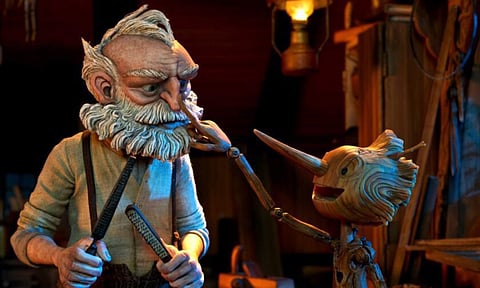Pinocchio Movie Review: A heartwarming tale about finding beauty in the ephemerality of existence
Rating:(4 / 5)
There is something poetic about a story where a puppet trying to become a real boy is being made with stop-motion animation, which is essentially puppets coming to life through the magic of cinema. I’m not going to spoil things by telling you if the puppet boy became a real boy, but the film, with all its masterful animation, did come alive in myriad ways.
Director: Guillermo Del Toro & Mark Gustafson
Cast: Gregory Mann, Ewan McGregor, Finn Wolfhard, Ron Perlman, David Bradley, Tilda Swinton, Cate Blanchett, and Christoph Waltz
Network: Netflix
Pinocchio is Guillermo Del Toro’s take on the classic children’s tale written by Italian writer Carlo Collodi in 1883. The themes of the story, as well as its cultural impact, have been explored in length for well over a century but Del Toro’s take on it—while once again proving to us the timelessness of the story—provides fresh warmth by rekindling an old ember.
Del Toro has a distinct visual language, a beautiful confluence of baroque aesthetics, and a moody ambiance pervading his frames. Such a precise, Del Toro-Esque visual tone is often accentuated the most whenever the filmmaker touches upon modern fairytales. You could see it in some of his best works like Pan's Labyrinth, Nightmare Alley, and to an unmissable extent in Pinocchio. Some of the most imaginative displays of visual design in this film can be seen with two supernatural beings; one is the Wood Sprite who brings the wooden puppet to life and the second one is her sister Death who meets Pinocchio at pivotal moments to impart wisdom about relationships, sacrifice, and immortality. The design of the Wood Sprite and Death, with their multiple eyes and wings, seems to have drawn their inspiration straight from the imagery of angels as originally described in the Bible. At times, such allusions to Biblical imagery become a commentary on religion itself, like in the scene when after Pinocchio gets verbally attacked by a mob startled by a talking puppet, he asks his father Geppetto why they seem to love the man on the cross and hate him while they are both made of wood.
While on a surface level Pinocchio might be a classic adventure about a boy growing up and a father learning to love again, the film unravels the multiple layers it holds with a pace backed by confidence in every frame, every line of dialogue, and every moment of silence in between. On a level right beneath its surface, Pinocchio is a poignant concoction of themes like horrors of war, fascism, existentialism, death, sacrifice, learning to let go, and learning to value the things we love.
Perhaps bogged down by expectations from previous interpretations of the story, the film rather half-heartedly attempts musical numbers during the first half of the story. None of the songs stick to your memory and the film’s pace could have easily benefitted from their omission. On the other hand, one of the most ingenious reinterpretations that the film does is the idea of having the ‘talking cricket’ as a sophisticated, world-weary writer who hangs pictures of Arthur Schopenhauer on his walls and who literally lives inside the wooden boy’s heart and serves as his inner voice. While Sebastian J Cricket gets his own character arc, his journey through the story and his philosophical musings struggle to blend in with the central narrative of the story. His conversations with Pinocchio don’t incite the kind of character-changing evolution brought forth by Pinocchio’s epiphanic interactions with Death or the Wood Sprite. While his presence was greatly appreciated, the film could have still worked in his absence.
With the story being set in Fascist Italy, we get brilliant patches of messages about military propaganda, the ill effects of nationalism, and fathers crushing their children’s spirits by imposing upon them their own will and expectations. These are shown through the tension between Podesta and his son Candlewick, the on-the-nose anti-war message expounded through Pinocchio’s debasement of Volpe’s play, the sequence where we see young boys being sent to military training camps, and we even get to see a perpetually miffed Mussolini. While these sequences serve as entertaining moments in the film and they do help Pinocchio’s character evolution, our attention shatters from an overload and deliberate overindulgence in such themes.
Despite its heavily loaded thematic flesh—at its core—Pinocchio is a heartwarming tale about a wide-eyed boy learning what it means to grow up and what it takes to protect those we love. It is hard to not get swept up with the emotional crescendo of the film’s climax but if Pinocchio never tugs at your heart at any moment, I hope you learn to live with a longer nose.

